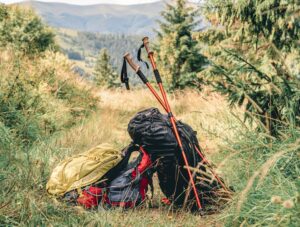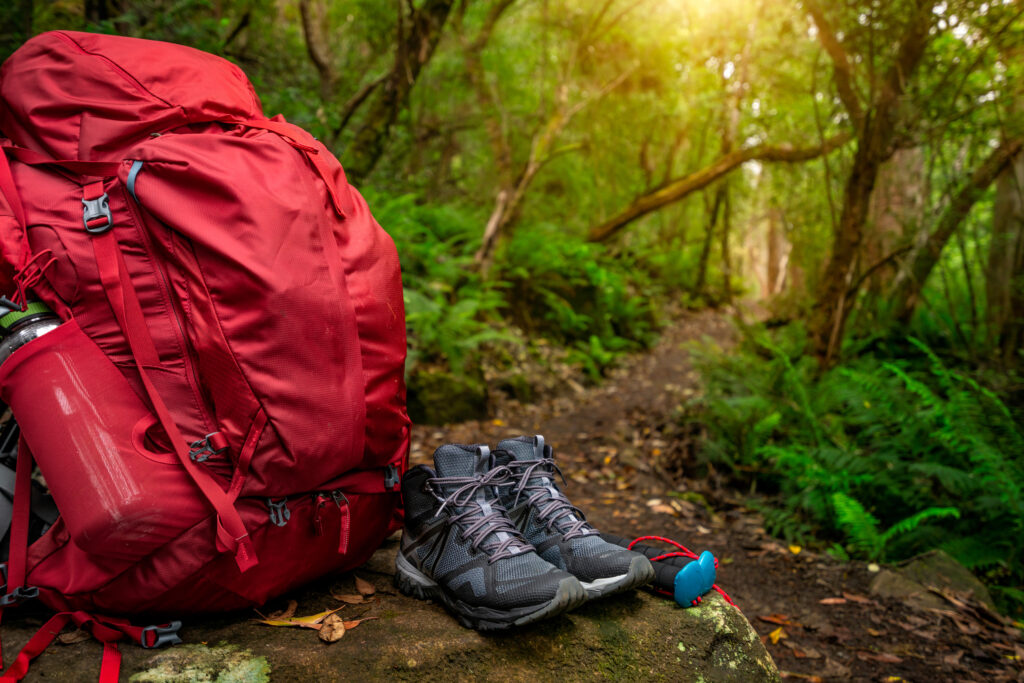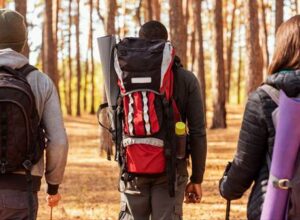The weight of the foods
Although you’ll need to bring a certain amount of gear with you when you go hiking, choose lighter gear where possible. You may choose a foil-lined sleeping bag over a thick down one, for example. Similarly, foods that are as light as possible and have minimal packaging are best.
In some cases, pre-made meals with their existing foil or tin can packaging may be the best solution if you need nutritious, portable food that will remain edible for a few days. You could also choose reusable silicone pouches, foil pouches, and sandwich bags, as well as lightweight airtight containers. You can’t exactly lug around a cooler box!


Packing – divide into portions
Speaking of storage and packaging, you’ll also need to think about how you divide your food up as you pack it. Some hikers prefer to snack regularly rather than having three large meals every day. This way, you feel less weighed down, and your muscles have less of a chance to get stiff, so you can keep going. Snacking also gives you more consistent energy levels when hiking.
If you choose this approach, you’ll want easy access to your snacks as you walk. This means something that you can keep in your pocket or at the top of your bag.
On a multi-day trek, you’ll probably want to take a break at least once a day. If you choose to take breaks for meals during your hike, consider putting all the ingredients you need for one-pot meals into one container. This will also help you reduce the amount of cookware you carry. You can get curry sauces in the shop that already contain vegetables, as well as other convenient jar foods and preserves. The glass may make your pack heavier, however, so just pack one or two of these.
Hiking is one of Australia’s most popular leisure activities, with thousands of locals and visitors traversing trails through our rainforests, mountains, coastlines and Outback. But, no matter your destination, a poorly packed hiking pack can transform a promising hiking adventure into a heavy burden. For this reason, understanding how to pack a hiking pack efficiently is essential for enjoying the outdoors with confidence.
This guide will explain how to organise your gear for comfort, safety, and ease of packing. Brought to you with the support of Caravan & Camping NSW, your one-stop shop for outdoor products, planning tools, and travel services to help you explore the best holiday parks and experiences across NSW.
Key Takeaways
- Choose the right hiking pack for your trip, making sure it fits well and supports the load you need to carry.
- Pack essential gear based on hike duration, from the bare minimum for short walks to full setups for extended treks.
- Use packing techniques like layering, compression, and waterproofing to stay organised and comfortable on the trail.
- Make smart use of pockets to keep important items within easy reach and plan for accessibility mid-hike.
- Adjust your approach based on weather and trail conditions to stay safe and make the most of your time outdoors.
- Avoid common mistakes such as poor pack fit, overpacking, or failing to separate wet and dry gear.
Understanding Your Hiking Pack
Before you start packing, make sure you have the right pack for your adventure. If you’re on the trail for a few hours, a small day pack suffices. But if you’re hiking overnight or for multiple days, a larger hiking pack is essential to provide proper load-carrying support.
Look for the best hiking packs suited to Australian terrain – breathable, durable and adjustable. A well-fitting pack means you fully adjust the shoulder straps and hip belt so your equipment is as close and comfortable as possible, minimising strain while carrying a heavier load.
Choosing the Essential Hiking Gear
What you take with you depends on how far your hike will go. If you’re heading out on a short bushwalk, you may only need the bare essentials, such as water, trail mix, a first aid kit and possibly a rain jacket.
If your hike is longer, your gear might include a sleeping bag, cooking equipment and additional first aid items. Terrain in NSW can shift from hot, dry tracks to damp forest, so make sure your gear suits the conditions and focus on what you genuinely need to take.
You need to consider each item from your sleeping pad to your toilet paper, and ask yourself ‘what is its purpose, and does it earn its place?’

6 Strategic Packing Principles for Maximum Comfort
1. Balance Your Pack for Comfortable Hiking
When packing your pack, heavier items should be placed close to your back and near your centre of gravity. This helps keep the weight central, making the pack feel more balanced on longer treks. Placing heavy items further from your body can throw off your balance, especially for beginner hikers tackling uneven terrain.
2. Layer Your Gear from Bottom to Top
Start by packing the bottom of your pack with your sleeping system – for example, your sleeping mat, sleeping bag and any bulky items you won’t need during the day. In the main compartment, pack clothing, food and cooking gear. Use the top lid pocket for easy-access items.
3. Waterproofing Your Essential Items
Because NSW weather can change quickly, using pack liners and dry bags will help keep your gear fully waterproof. A wet sleeping bag can easily ruin your night. Important items – such as your sleeping bag, dry clothes and food – should be packed in dry sacks or separate compartments to protect them from bad weather.
4. Smart Use of All Available Pockets
The hip belt pouch is great for small essentials – like lip balm, a pocket knife and snacks. Side pockets are useful for a water bottle, walking pole or wet gear. Use the lid pocket or top lid compartment for maps, your first aid kit or anything else you need to access quickly while on the move.
5. Compression and Space Maximisation
Compression straps are great for reducing the volume of your pack and stabilising heavier gear. A stuff sack will help manage clothing and loose items. Many packs have built-in organiser pockets to keep your gear in place, so be sure to use every pocket and compartment.
6. Accessibility Planning for Trail Needs
Think about what you might need when you’re midway through a hike. Try to pack your rain jacket, an extra layer or even your first aid kit near the top of your pack or in an outer pocket, so you can access it quickly. Avoid placing heavy items where they block access to your essentials.
Essential Gear Checklist Based on Hike Duration
Your packing list should match the duration and intensity of your hike. Whether you’re heading out for a few hours or a few days, ensuring you have the right gear will help you to hike with safety and enjoyment. Below, we’ve provided a breakdown of must-haves based on hike length to help you plan smarter.
- Few Hours (Day Hikes): If you’re out for a few hours, carry only the bare minimum. Bring water bottles or a hydration bladder, trail mix, hiking boots, a first aid kit, toilet paper, lip balm and a pocket knife. Use a pack liner to keep everything dry, and opt for a small hiking pack for easy mobility.
- Overnight Hike: You’ll need to carry a sleeping bag, sleeping mat, cooking gear and food. Include dry clothes, toilet paper and walking poles, and keep your first aid kit within easy reach. It’s highly recommended to use separate dry bags or at least a stuff sack to keep your gear organised. A rain cover and pack liner are also good to have in case of wet weather.
- Extended Adventures: Add a personal locator beacon, extra food, dry sacks, and a pack cover. You’ll need backup gear, more water, and the right pack weight balance to carry it all. Include a closed-cell foam mat for extra comfort and insulation.
Packing Strategies for Differing Conditions
Packing smart means adjusting to the conditions you’ll face. Here are quick tips to help you stay safe, organised, and comfortable in wet weather, hot days, multi-day treks, and emergencies.
- Wet Conditions: This should go without saying, but always use a rain cover and pack liner to keep your gear totally waterproof. Avoid putting wet gear in with dry clothes. If your sleeping bag gets soaked, put it in a sealed section of your pack.
- Hot Weather: Place water bottles in side pockets and lip balm in your hip belt pockets, for easy access.
- Multi-Day Treks: If you’re hiking for more than one day, a comfortable sleeping pad makes a big difference. Store your food in sealed dry bags to prevent spoilage, and use separate compartments if you’re carrying different meals or snacks.
- Safety First: Your personal locator beacon (PLB) needs to be in a lid pocket or on the outside of your pack.
Common Packing Mistakes to Avoid
Avoid packing light items too far from your back. Doing so can shift your centre of gravity and lead to discomfort. Many beginners forget to properly fit their pack and often fail to adjust the shoulder straps and hip belt correctly.
Failing to waterproof your gear can leave your clothing and equipment soaked. Don’t overpack – carrying more weight than necessary will affect your comfort.
Remember to pack essential items, such as your aid kit, rain jacket, or trail food. Wearing the wrong footwear can also cause discomfort – make sure your hiking boots are well broken-in and suited for the trail.
Start Your Most Memorable Adventure with Confidence
Packing your hiking pack properly isn’t just a time-saver – it sets you up for a safer, smoother trip. From your shoulder strap to your stuff sack, every part of your gear system matters. Whether you’re heading out for a few hours or planning an overnight hike, smart packing helps you move comfortably, stay prepared and make the most of your time in nature.
If you’re ready to embark on your next adventure, find your local holiday park here and start exploring with Caravan & Camping NSW.







